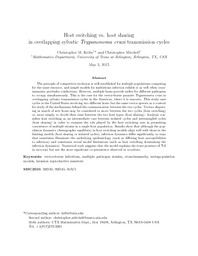| dc.contributor.author | Kribs, Christopher David | |
| dc.contributor.author | Mitchell, Christopher | |
| dc.date.accessioned | 2016-10-13T16:28:55Z | |
| dc.date.available | 2016-10-13T16:28:55Z | |
| dc.date.issued | 2015-09 | |
| dc.identifier.citation | Published in the Journal of Biological Dynamics 9(1):247-277,2015 | en_US |
| dc.identifier.issn | 1751-3758 | |
| dc.identifier.issn | 1751-3766 | |
| dc.identifier.uri | http://hdl.handle.net/10106/26058 | |
| dc.description.abstract | The principle of competitive exclusion is well established for multiple populations competing for the same resource, and simple models for multistrain infection exhibit it as well when cross-immunity precludes coinfections. However, multiple hosts provide niches for different pathogens to occupy simultaneously. This is the case for the vector-borne parasite Trypanosoma cruzi in overlapping sylvatic transmission cycles in the Americas, where it is enzootic. This study uses cycles in the USA involving two different hosts but the same vector species as a context for the study of the mechanisms behind the communication between the two cycles. Vectors dispersing in search of new hosts may be considered to move between the two cycles (host switching) or, more simply, to divide their time between the two host types (host sharing). Analysis considers host switching as an intermediate case between isolated cycles and intermingled cycles (host sharing) in order to examine the role played by the host-switching rate in permitting coexistence of multiple strains in a single-host population. Results show that although the population dynamics (demographic equilibria) in host-switching models align well with those in the limiting models (host sharing or isolated cycles), infection dynamics differ significantly, in ways that sometimes illuminate the underlying epidemiology (such as differing host susceptibilities to infection) and sometimes reveal model limitations (such as host switching dominating the infection dynamics). Numerical work suggests that the model explains the trace presence of TcI in raccoons but not the more significant co-persistence observed in woodrats. | en_US |
| dc.description.sponsorship | This work was partially supported by a 2008 Norman Hackerman Advanced Research Program grant, and by the National Science Foundation under grant DMS-1020880. CMK acknowledges the support of a Marie Curie Fellowship (IIF) from the European Commission while at the University of Lyon 1, with funding from the European Union Seventh Framework Programme [FP7/2007–2011] under grant agreement no. 219266. | en_US |
| dc.language.iso | en_US | en_US |
| dc.publisher | Taylor & Francis Open | en_US |
| dc.subject | Vector-borne infections | en_US |
| dc.subject | Multiple pathogen strains | en_US |
| dc.subject | Cross-immunity | en_US |
| dc.subject | Metapopulation models | en_US |
| dc.subject | Invasion reproductive numbers | en_US |
| dc.title | Host switching vs. host sharing in overlapping sylvatic Trypanosoma cruzi transmission cycles | en_US |
| dc.type | Article | en_US |
| dc.publisher.department | Department of Mathematics, University of Texas at Arlington | |
| dc.identifier.externalLinkDescription | The original publication is available at Article DOI. | |
| dc.rights.license | Licensed under Creative Commons, CC BY | |
| dc.identifier.doi | http://dx.doi.org/10.1080/17513758.2015.1075611 | |

